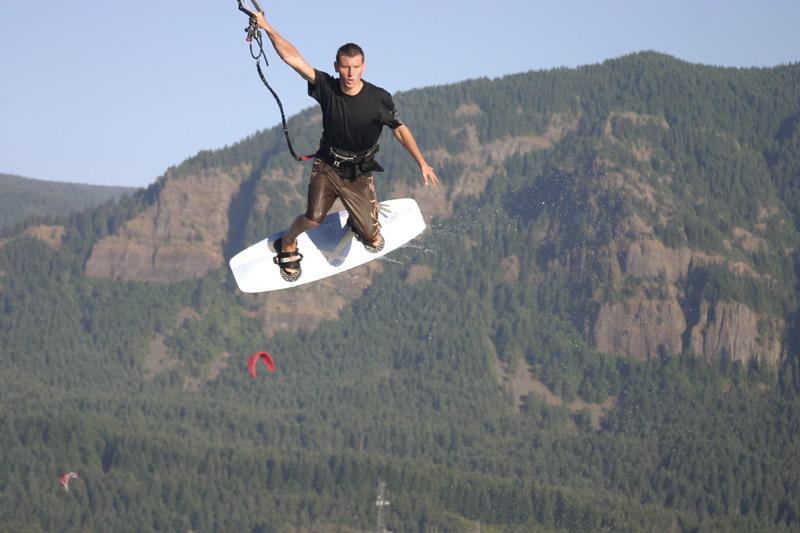kitesurfing in light winds
here is a great article on kite surfing in light winds.
Article Search Engine: GoArticles.com
Kiteboarding / kitesurfing in light wind is tricky; flying the kite requires extra focus and finesse. This is due to the fact that the kite is often teetering on the edge of stalling and the smallest mistake will usually cause the kite to fall from the sky. Understanding how the kite behaves differently in light wind is a step in the right direction. The biggest factor is apparent wind, one must understand what apparent wind is and how to make it work.
Apparent wind is the vector addition of the true wind speed, and the speed the rider is traveling. Consider the example where we have 10 knots of N wind, and you are riding E at 10 knots. The kite is feeling about 14 knots at this point. So by riding the rider is creating extra wind for the kite to use. However take the same example but lets ride downwind. If the wind is 10, and you're riding in the same direction at 10, the kite feels 0. Remember launching a single line kites as children, someone holds the kite and then lets go as we ran into the wind. As children we already had a concept of apparent wind.
Starting now with launching the kite we will recall that the farther upwind the bar is of the kite, the more power in the launch. By choosing the correct launch angle, getting the kite up in the air is easier. Many kites especially some the new flat kites, do not like to be launched with much rear line tension, this is also true for water relaunch, and when moving the kite from low on the sides back up to neutral. It is counter intuitive that pushing the bar away a bit often helps in these cases. When bringing the kite from low on the edge to neutral focus on the center strut, as the kite comes up try to keep the center strut almost parallel to the horizon, too much angle will cause the kite to stall. This idea can also be used to stabilize a kite which is about to stall, bring the strut down to parallel with the horizon. This allows the kite to stabilize by moving across the window and since the kite is moving side to side it doesn't have to fight gravity as much as it does when moving up, or against gravity.
Once the kite is up in the air avoid walking down wind if possible when moving to the water. If this can not be avoided keep the kite moving between 11 and 1 o'clock and make the way slowly. Keeping the kite high in the window gives us more time to react to luffing and stalling. Also avoid parking the kite in neutral, again , [color=red][/color][size=18][/size]Do not park the kite in neutral!, try instead 1 or 11. When the kite does stall push the bar away and turn the kite making the center strut parallel with the horizon, (turn kite down). Once the kite catches the wind bring it to a stable parked postion. Mastering keeping the kite up long enough to get to the water and up on the board on is the first challenge of light wind kitesurfing.
Once we get into the water we slap the board on quickly and without hesitation dive the kite, start kiteboarding / kitesurfing as quick as possible. Remember once you have the board on your feet you begin drifting with the kite which reduces the apparent wind. I usually loop the kite once or twice to get moving then stick with flying the kite up and down on the side of the wind window. I also down loop the kite when doing a slide transition, which in light wind is more of a pivot. Light wind is the best for learning to loop the kite while riding. Be cafeful looping when the wind is higher until you've practiced in the lighter stuff. And remember that downlooping is usually safer that uplooping as going up will generate lift.
The idea now is to work the edge of the board with the kite to generate as much speed as possible. The more speed we can get the more apparent wind the kite gets, and the more power we get. At this point over-edging will slow us down killing the apparent wind, conversely too little edge and we find ourselves following the kite which also kills the power. The more common of the two mistakes is over edging. The secret is the edge pressure must be varied as the kite moves up and down in the wind window. As the kite powers up during the power-stroke the edge pressure is gradually increased, as the kite begins to depower or turn, the pressure is decreased. This will take some practice and patience.
Getting good at kiteboarding in light wind is a great way to get more days on the water. Some of us don't live in places where it blows 20 every day, so being able to turn a light wind day into a fun day on the water would be great. Keeping the kite in the air while moving to the water and putting the board on is tough. Try practicing flying the kite in light wind without the board if you are having trouble with this step. Once in the water get up and riding as quickly as possible, thus getting apparent wind working for you. Keep your speed up and don't edge too much. By getting the right techniques you can be staying upwind and jumping while friends are watching form the shore waiting for more wind.
Captain J Hoxtell www.airpadrekiteboarding.com
Technorati Tags: kitesurfing, light, winds.

